- Home
- C. S. Lewis
The Discarded Image Page 2
The Discarded Image Read online
Page 2
But there is a third work which we can, I think, set beside these two. This is the medieval synthesis itself, the whole organisation of their theology, science, and history into a single, complex, harmonious mental Model of the Universe. The building of this Model is conditioned by two factors I have already mentioned: the essentially bookish character of their culture, and their intense love of system.
They are bookish. They are indeed very credulous of books. They find it hard to believe that anything an old auctour has said is simply untrue. And they inherit a very heterogeneous collection of books; Judaic, Pagan, Platonic, Aristotelian, Stoical, Primitive Christian, Patristic. Or (by a different classification) chronicles, epic poems, sermons, visions, philosophical treatises, satires. Obviously their auctours will contradict one another. They will seem to do so even more often if you ignore the distinction of kinds and take your science impartially from the poets and philosophers; and this the medievals very often did in fact though they would have been well able to point out, in theory, that poets feigned. If, under these conditions, one has also a great reluctance flatly to disbelieve anything in a book, then here there is obviously both an urgent need and a glorious opportunity for sorting out and tidying up. All the apparent contradictions must be harmonised. A Model must be built which will get everything in without a clash; and it can do this only by becoming intricate, by mediating its unity through a great, and finely ordered, multiplicity. This task, I believe, the Medievals would in any case have undertaken. But they had a further inducement in the fact that it had already been begun, and indeed carried a fair way. In the last age of antiquity many writers—some of them will meet us in a later chapter—were, perhaps half-consciously, gathering together and harmonising views of very different origin: building a syncretistic Model not only out of Platonic, Aristotelian, and Stoical, but out of Pagan and Christian elements. This Model the Middle Ages adopted and perfected.
In speaking of the perfected Model as a work to be set beside the Summa and the Comedy, I meant that it is capable of giving a similar satisfaction to the mind, and for some of the same reasons. Like them it is vast in scale, but limited and intelligible. Its sublimity is not the sort that depends on anything vague or obscure. It is, as I shall try to show later, a classical rather than a Gothic sublimity. Its contents, however rich and various, are in harmony. We see how everything links up with everything else; at one, not in flat equality, but in a hierarchical ladder. It might be supposed that this beauty of the Model was apparent chiefly to us who, no longer accepting it as true, are free to regard it—or reduced to regarding it—as if it were a work of art. But I believe this is not so. I think there is abundant evidence that it gave profound satisfaction while it was still believed in. I hope to persuade the reader not only that this Model of the Universe is a supreme medieval work of art but that it is in a sense the central work, that in which most particular works were embedded, to which they constantly referred, from which they drew a great deal of their strength.
CHAPTER 2
RESERVATIONS
I do not exercise myself in great matters:
which are too high for me.
PSALM CXXXI
To describe the imagined universe which is usually pre-supposed in medieval literature and art is not the same thing as writing a general history of medieval science and philosophy.
The Middle Ages, like most ages, were full of change and controversy. Schools of thought rose, contended, and fell. My account of what I call the Medieval Model ignores all this: ignores even the great change from a predominantly Platonic to a predominantly Aristotelian1 outlook and the direct conflict between Nominalists and Realists. It does so because these things, however important for the historian of thought, have hardly any effect on the literary level. The Model, as regards those elements in it which poets and artists could utilise, remained stable.
Again, the reader will find that I freely illustrate features of the Model which I call ‘Medieval’ from authors who wrote after the close of the Middle Ages; from Spenser, Donne or Milton. I do so because, at many points, the old Model still underlies their work. It was not totally and confidently abandoned till the end of the seventeenth century.
In every period the Model of the Universe which is accepted by the great thinkers helps to provide what we may call a backcloth for the arts. But this backcloth is highly selective. It takes over from the total Model only what is intelligible to a layman and only what makes some appeal to imagination and emotion. Thus our own backcloth contains plenty of Freud and little of Einstein. The medieval backcloth contains the order and influences of the planets, but not much about epicycles and eccentrics. Nor does the backcloth always respond very quickly to great changes in the scientific and philosophical level.
Furthermore, and apart from actual omissions in the backcloth version of the Model, there will usually be a difference of another kind. We may call it a difference of status. The great masters do not take any Model quite so seriously as the rest of us. They know that it is, after all, only a model, possibly replaceable.
The business of the natural philosopher is to construct theories which will ‘save appearances’. Most of us first meet this expression in Paradise Lost (VIII, 82) and most of us perhaps originally misunderstood it. Milton is translating σωζειν τὰ ϕαινόμενα, first used, so far as we know, by Simplicius in his commentary on the Aristotelian De Caelo. A scientific theory must ‘save’ or ‘preserve’ the appearances, the phenomena, it deals with, in the sense of getting them all in, doing justice to them. Thus, for example, your phenomena are luminous points in the night sky which exhibit such and such movements in relation to one another and in relation to an observer at a particular point, or various chosen points, on the surface of the Earth. Your astronomical theory will be a supposal such that, if it were true, the apparent motions from the point or points of observation would be those you have actually observed. The theory will then have ‘got in’ or ‘saved’ the appearances.
But if we demanded no more than that from a theory, science would be impossible, for a lively inventive faculty could devise a good many different supposals which would equally save the phenomena. We have therefore had to supplement the canon of saving the phenomena by another canon—first, perhaps, formulated with full clarity by Occam. According to this second canon we must accept (provisionally) not any theory which saves the phenomena but that theory which does so with the fewest possible assumptions. Thus the two theories (a) that the bad bits in Shakespeare were all put in by adapters, and (b) that Shakespeare wrote them when he was not at his best, will equally ‘save’ the appearances. But we already know that there was such a person as Shakespeare and that writers are not always at their best. If scholarship hopes ever to achieve the steady progress of the sciences, we must therefore (provisionally) accept the second theory. If we can explain the bad bits without the assumption of an adapter, we must.
In every age it will be apparent to accurate thinkers that scientific theories, being arrived at in the way I have described, are never statements of fact. That stars appear to move in such and such ways, or that substances behaved thus and thus in the laboratory—these are statements of fact. The astronomical or chemical theory can never be more than provisional. It will have to be abandoned if a more ingenious person thinks of a supposal which would ‘save’ the observed phenomena with still fewer assumptions, or if we discover new phenomena which it cannot save at all.
This would, I believe, be recognised by all thoughtful scientists today. It was recognised by Newton if, as I am told, he wrote not ‘the attraction varies inversely as the square of the distance’, but ‘all happens as if’ it so varied. It was certainly recognised in the Middle Ages. ‘In astronomy’, says Aquinas, ‘an account is given of eccentrics and epicycles on the ground that if their assumption is made (hac positione facta) the sensible appearances as regards celestial motions can be saved. But this is not a strict proof (sufficienter probans) since for
all we know (forte) they could also be saved by some different assumption.’2 The real reason why Copernicus raised no ripple and Galileo raised a storm, may well be that whereas the one offered a new supposal about celestial motions, the other insisted on treating this supposal as fact. If so, the real revolution consisted not in a new theory of the heavens but in ‘a new theory of the nature of theory’.3
On the highest level, then, the Model was recognised as provisional. What we should like to know is how far down the intellectual scale this cautious view extended. In our age I think it would be fair to say that the ease with which a scientific theory assumes the dignity and rigidity of fact varies inversely with the individual’s scientific education. In discussion with wholly uneducated audiences I have sometimes found matter which real scientists would regard as highly speculative more firmly believed than many things within our real knowledge; the popular imago of the Cave Man ranked as hard fact, and the life of Caesar or Napoleon as doubtful rumour. We must not, however, hastily assume that the situation was quite the same in the Middle Ages. The mass media which have in our time created a popular scientism, a caricature of the true sciences, did not then exist. The ignorant were more aware of their ignorance then than now. Yet I get the impression that when the poets use motives from the Model, they are not aware, as Aquinas was, of its modest epistemological status. I do not mean that they have raised the question he raises and answered it differently. More probably it has never been before their minds. They would have felt that the responsibility for their cosmological, or for their historical or religious, beliefs rested on others. It was enough for them that they were following good auctours, great clerks, ‘thise olde wise’.
Not only epistemologically but also emotionally the Model probably meant less to the great thinkers than to the poets. This, I believe, must be so in all ages. Quasi-religious responses to the hypostatised abstraction Life are to be sought in Shaw or Wells or in a highly poetical philosopher such as Bergson, not in the papers and lectures of biologists. Delight in the Medieval Model is expressed by Dante or Jean de Meung rather than by Albertus and Aquinas. Partly, no doubt, this is because expression, of whatever emotion, is not the business of philosophers. But I suspect this is not the whole story. It is not in the nature of things that great thinkers should take much interest in Models. They have more difficult and more controversial matters in hand. Every Model is a construct of answered questions. The expert is engaged either in raising new questions or in giving new answers to old ones. When he is doing the first, the old, agreed Model is of no interest to him; when he is doing the second, he is beginning an operation which will finally destroy the old Model altogether.
One particular class of experts, the great spiritual writers, ignore the Model almost completely. We need to know something about the Model if we are to read Chaucer, but we can neglect it when we are reading St Bernard or The Scale of Perfection or the Imitation. This is partly because the spiritual books are entirely practical—like medical books. A man concerned about the state of his soul will not usually be much helped by thinking about the spheres or the structure of the atom. But perhaps there was in the Middle Ages another factor also at work. Their cosmology and their religion were not such easy bedfellows as might be supposed. At first we may fail to notice this, for the cosmology appears to us, in its firmly theistic basis and its ready welcome to the supernatural, to be eminently religious. And so in one sense it is. But it is not eminently Christian. The Pagan elements embedded in it involved a conception of God, and of man’s place in the universe, which, if not in logical contradiction to Christianity, were subtly out of harmony with it. There was no direct ‘conflict between religion and science’ of the nineteenth-century type; but there was an incompatibility of temperament. Delighted contemplation of the Model and intense religious feeling of a specifically Christian character are seldom fused except in the work of Dante.
One difference between describing the Model and writing a history of thought has been, undesignedly, illustrated in the previous chapter. I there cited both Plato and Aristotle: but the role I had to give them was philosophically humiliating—the one called as witness to a scrap of daemonology, the other for some exploded physics. Naturally, I was not suggesting that their real and permanent place in the history of Western thought rested on such foundations. But they concerned us less as great thinkers than as contributors—indirect, unconscious, and almost accidental contributors—to the Model. The history of thought as such would deal chiefly with the influence of great experts upon great experts—the influence, not of Aristotle’s physics, but of his ethics and his dialectical method on those of Aquinas. But the Model is built out of the real, or supposed, agreement of any ancient authors—good or bad, philosophers or poets, understood or misunderstood—who happened, for whatever reason, to be available.
These explanations will perhaps set at rest, or re-direct, one doubt which a prospective reader might possibly feel on first dipping here and there into this book. I can imagine such a preliminary reconnaissance leading to the question ‘But how far down the intellectual scale did this Model of yours penetrate? Are you not offering as the background for literature things which were really known only to a few experts?’ It will now be seen, I hope, that the question ‘how far up’ the real potency of the Model was operative is at least equally pertinent.
There was no doubt a level below the influence of the Model. There were ditchers and alewives who had not heard of the Primum Mobile and did not know that the earth was spherical; not because they thought it was flat but because they did not think about it at all. Nevertheless, elements from the Model appear in such a homely and artless compilation as the South English Legendary. On the other hand, as I have tried to indicate, there were certainly levels, both intellectual and spiritual, which were in a sense above the Model’s full power.
I say ‘in a sense’ because these metaphors of above and below might otherwise carry a false suggestion. It might be supposed that I believe science and philosophy to be somehow intrinsically more valuable than literature and art. I hold no such view. The ‘higher’ intellectual level is higher only by one particular standard: by another standard the poetic level is higher. Comparative evaluations of essentially different excellences are in my opinion senseless.4 A surgeon is better than a violinist at operating and a violinist better than a surgeon at playing the violin. Nor am I at all suggesting that the poets and artists are wrong or stupid in omitting from their backcloth much which the experts think important. An artist needs some anatomy; he need not go on to physiology, much less to biochemistry. And if these sciences change much more than anatomy changes, his work will not reflect their progress.
CHAPTER 3
SELECTED MATERIALS: THE CLASSICAL PERIOD
Oh vana gloria de l’umane posse
com poco verde in su la cima dura.
DANTE
Before turning to the Model itself it will be well to give an account of some at least among the sources from which it was derived. To deal with all would be far beyond the scope of this book and would lead me into regions where better guides can easily be found. Thus there are perhaps no sources so necessary for a student of medieval literature to know as the Bible, Virgil, and Ovid, but I shall say nothing about any of the three. Many of my readers know them already; those who do not are at least aware that they need to. Again, though I shall have much to say about the old astronomy, I shall not describe Ptolemy’s Almagest. The text, with a French translation,1 is available and many histories of science exist. (Casual statements about pre-Copernican astronomy in modern scientists who are not historians are often unreliable.) I shall concentrate on those sources which are least easily accessible or least generally known to educated people, or which best illustrate the curious process whereby the Model assimilated them. Those which seem to me most important belong to the third, fourth and fifth centuries A.D., and these will form the subject of the next chapter. In the meantime I turn to certain ear
lier works which the ‘classical’ tradition in our schools has tended to keep in the background.
A. THE SOMNIUM SCIPIONIS2
Plato’s Republic, as everyone knows, ends with an account of the after-life, put into the mouth of one Er the Armenian who had returned from the dead. When Cicero, somewhere about 50 B.C., wrote his own Republic, not to be outdone, he ended with a similar vision. Scipio Africanus Minor, one of the speakers in Cicero’s dialogue, relates in the sixth and last book a remarkable dream. Most of Cicero’s Republic has reached us in a fragmentary condition. For a reason which will appear later, this part, the Somnium Scipionis, has come down intact.
Scipio begins by telling us that during the evening which preceded his dream he had been talking about his (adoptive) grandfather, Scipio Africanus Major. That, he says, is doubtless why he appeared to me in my dream, for our dreams are commonly begotten by our recent waking thoughts (VI, X). This little attempt to give plausibility to a fictitious dream by offering psychological causes is imitated in the dream-poetry of the Middle Ages. Thus Chaucer in the Proem to the Book of the Duchesse reads of lovers parted by death before he dreams of them; in the Parlement he reads the Somnium Scipionis itself and suggests that this may be why he dreamed of Scipio (106–8).
Africanus Major carries Africanus Minor up to a height whence he looks down on Carthage ‘from an exalted place, bright and shining, filled with stars’ (xi). They are in fact in the highest celestial sphere, the stellatum. This is the prototype of many ascents to Heaven in later literature: those of Dante, of Chaucer (in the Hous of Fame), of Troilus’ ghost, of the Lover in the King’s Quair. Don Quixote and Sancho (II, xli) were once persuaded that they were making just such an ascent.

 The Lion, the Witch, and the Wardrobe
The Lion, the Witch, and the Wardrobe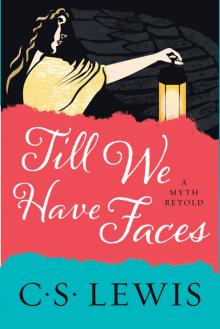 Till We Have Faces
Till We Have Faces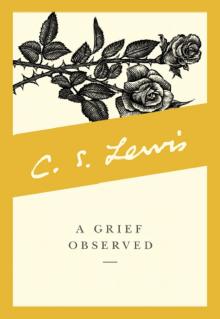 A Grief Observed
A Grief Observed The Voyage of the Dawn Treader
The Voyage of the Dawn Treader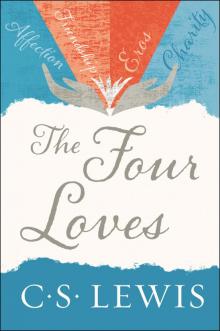 The Four Loves
The Four Loves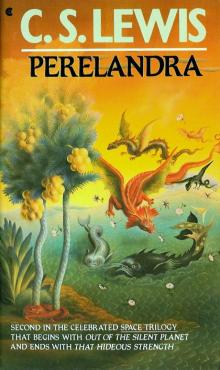 Perelandra
Perelandra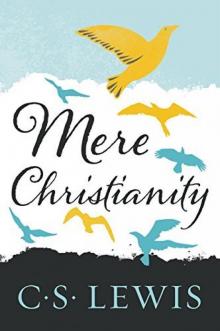 Mere Christianity
Mere Christianity Prince Caspian
Prince Caspian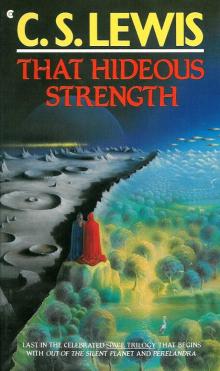 That Hideous Strength
That Hideous Strength The Magicians Nephew
The Magicians Nephew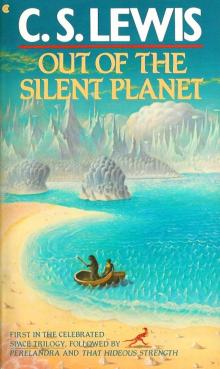 Out of the Silent Planet
Out of the Silent Planet The Screwtape Letters
The Screwtape Letters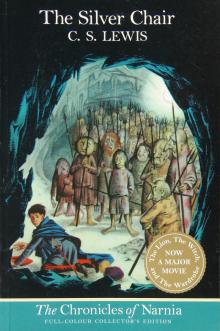 The Silver Chair
The Silver Chair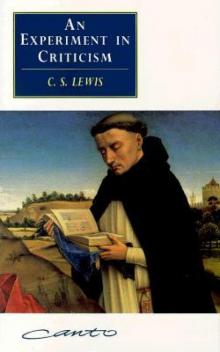 An Experiment in Criticism
An Experiment in Criticism The Horse and His Boy
The Horse and His Boy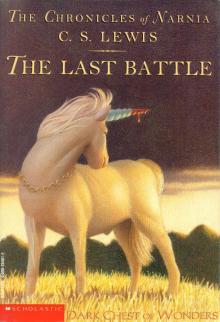 The Last Battle
The Last Battle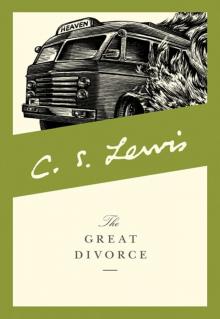 The Great Divorce
The Great Divorce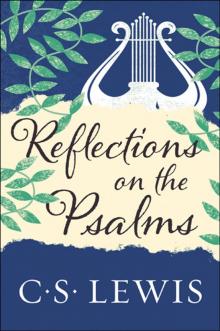 Reflections on the Psalms
Reflections on the Psalms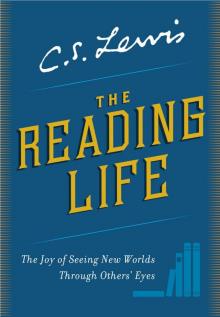 The Reading Life
The Reading Life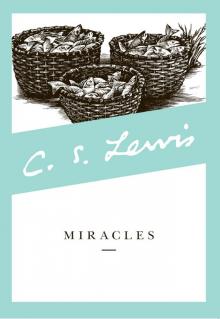 Miracles
Miracles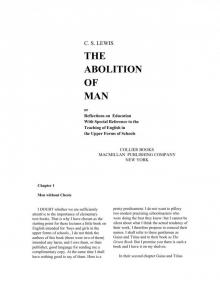 Lewis new
Lewis new Compelling Reason
Compelling Reason Letters of C. S. Lewis
Letters of C. S. Lewis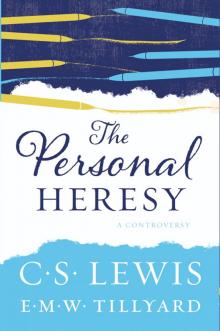 The Personal Heresy
The Personal Heresy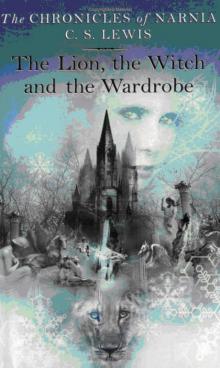 The Lion, The Witch And The Wardrobe
The Lion, The Witch And The Wardrobe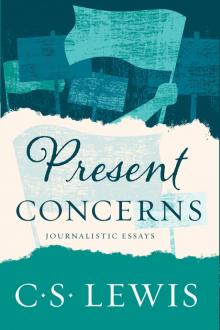 Present Concerns
Present Concerns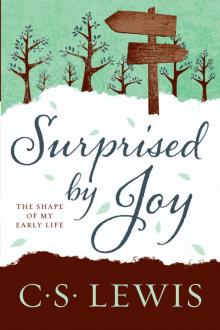 Surprised by Joy
Surprised by Joy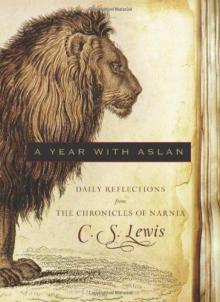 A Year with Aslan: Daily Reflections from The Chronicles of Narnia
A Year with Aslan: Daily Reflections from The Chronicles of Narnia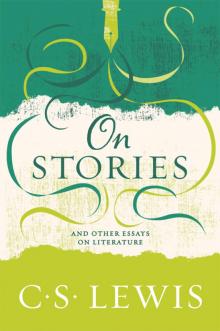 On Stories
On Stories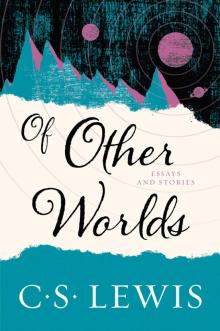 Of Other Worlds
Of Other Worlds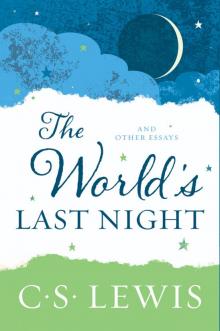 The World's Last Night
The World's Last Night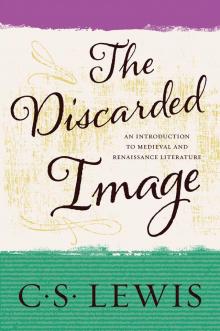 The Discarded Image
The Discarded Image The Chronicles of Narnia Complete 7-Book Collection with Bonus Book
The Chronicles of Narnia Complete 7-Book Collection with Bonus Book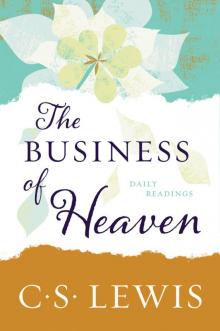 The Business of Heaven
The Business of Heaven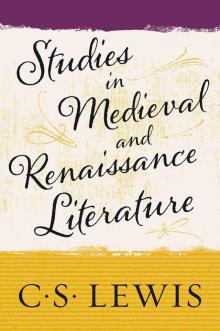 Studies in Medieval and Renaissance Literature
Studies in Medieval and Renaissance Literature The Dark Tower
The Dark Tower Narrative Poems
Narrative Poems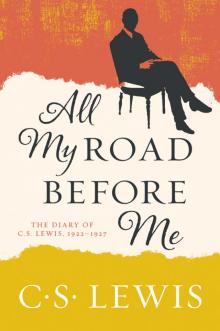 All My Road Before Me
All My Road Before Me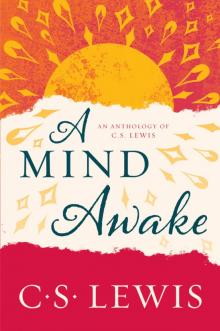 A Mind Awake
A Mind Awake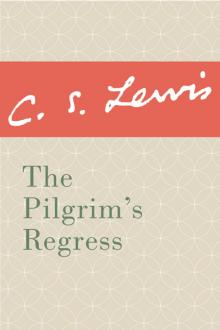 The Pilgrim's Regress
The Pilgrim's Regress